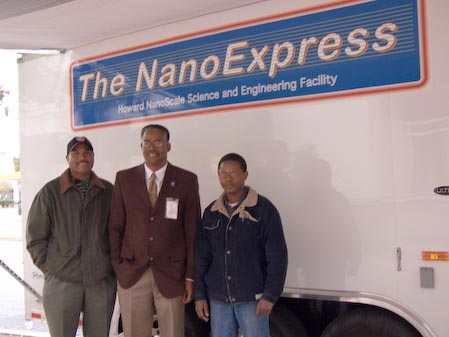For Students K-12
The nanoscale world is going to seem a bit bigger for visitors who get a chance to build, play with, and watch scale models of molecules in an interactive exhibit, "Too Small to See," which opened November 18 at Epcot's Innoventions at Walt Disney World, Lake Buena Vista, Fla. The exhibit, developed by scientists and educators from Cornell University, the Ithaca Sciencenter, and the design/fabrication firm Painted Universe is aimed at 8- to 13-year-olds. The exhibit, created with a $1.8 million grant from the National Science Foundation, helps young visitors to view the world at the atomic scale. “We hope visitors to ‘Too Small to See’ will leave with the notion that everything is moving and at the nanometer scale, science is fun,” said Project Director Carl Batt, the Liberty Hyde Bailey Professor of Food Science at Cornell. |
What's Your Nano IQ? Find out HERE!
Take a fun quiz on the National Institute of
Standards and Technology web site!
As the father of four children, Dr. Jim Tour knows a thing or two about kids. As a Professor of Chemistry, and Computer Science, Mechanical Engineering and Materials Science at Rice University in Houston, Texas, he knows a lot about science. What he’s most excited about today, though, is his NanoKids™ project—a DVD-based program that brings chemistry alive with rap, rock and pop music, dancing, and journeys to the nanoworld.
Cornell University NanoScale Science and Technology Facility has created a new science web magazine called Nanooze, a project of the National Nanotechnology Infrastructure Network (NNIN) -- a great place to hear about the latest exciting stuff in science and technology that is too small to see.
Let a click of your computer mouse transport you to London, England to their Science Museum's fantastic exhibit on Nanotechnology: Small Science, Big Deal -- and, as long as you are visiting that side of the Atlantic Ocean, be sure to go exploring with Duckboy in Nanoland!
Check out podcasts, cable TV news stories, and live presentation videos on current nanoscale research produced by the
Museum of Science, Boston!
"Discover the secrets of everyday stuff" on this SUPERCOOL web site Strange Matter. The Strange Matter exhibit will soon be in Durham, North Carolina (October 1 to January 8). See the Strange Matter web site for details on upcoming exhibits near you.
Nanotechnology has become FUN! through these and other programs, such as the adventures of NanoKids™, who materialize after a computer crashes in chemist Jim Tour's lab! (See the cool dancing Kids in the graphic below and the brains behind the Kids, chemist Jim Tour.) Video game lovers, this is for you!!
There are other great programs too. See also the Science News for Kids article about "The Incredible Shrunken Kids."
Atoms and molecules are the building blocks of nature, and a lot of kids worldwide are having fun using familar blocks, such as Legos®, and computer generated figures made of these ultra-basic materials.
See Exploring the Nanoworld with Lego® Bricks, an offering of the University of Wisconsin - Madison Materials Research Science and Engineering Center (MRSEC) Interdisciplinary Education Group (EG).
NanoKids™ The Nanobiotechnology Center is located at Cornell
University and is sponsored in collaboration with Princeton University, Oregon Health & Science University, Wadsworth Center, Clark Atlanta University, and Howard University.
Howard University in Washington, D.C., is taking nanoscience directly to the public with its NanoExpress trailer, or, as its creators call it, a “mobile science theme park.” By the end of this year, approximately 15,000 visitors are expected to visit the traveling exhibit at schools and local sporting events. The trailer offers information on nanoparticles, micro/nanofabrication, instruments for nanoscience, and characterization science. NanoExpress is a project of the Howard University Nanoscale Science and Engineering Facility, which is directed by Dr. Gary L. Harris and operates with support from the National Science Foundation through the National Nanotechnology Infrastructure Network and corporate funding. |
Especially For Teens
See ScienCentral News' nanotechnology videos, sponsored by the NSF. Start with this one on Clothes that Change Color.
See cartoons and photos
NASA Ames' Center for Nanotechnology Nanotechnology Gallery and NSF's super-colorful Nanoscience Screen Savers for your computer.
Nano*High
The University of California's Lawrence Berkeley National Lab is now offering high school teachers and students —with or without a science background— a series of free Saturday morning lectures and laboratory tours. Students and teachers will meet and talk with world-renowned UC Professors and Berkeley Lab scientists and graduate students, learning "about their research into the world of the ultra small and how it will affect our future." Go to Nano*High!
Explore a Career in Nanofabrication
Penn State University's Center for Nanotechnology Education and Utilization has a great video about "Careers in Nanofabrication" that you can view online or order a free copy. If you live in Pennsylvania, you might be able to attend a three-day summer “Nanotech Camp” for high school students from across Pennsylvania. These nanotech camps provide secondary school students with an orientation to basic nanofabrication processes and applications, and the opportunity to observe these same nanofabrication processes in the Penn State Nanofabrication Facility.
Attention Stamp Collectors!!
Physicist Richard Feynman is now appearing in post offices, mailboxes, and stamp collections. The U.S. Postal Service recently issued a 37-cent stamp that features this Nobel laureate, whose visionary 1959 speech "There's Plenty of Room at the Bottom" inspired scientists and engineers to imagine the potential of nanotechnology. Read more!

